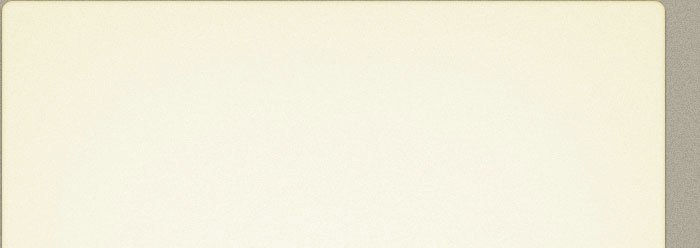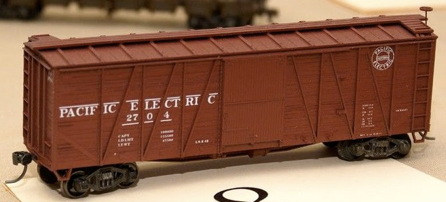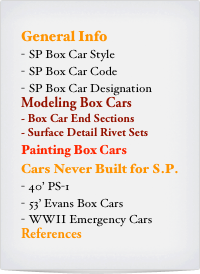Southern Pacific Lines
Coast Line Division
“The Route of the Octopus”

Southern Pacific Lines
Coast Line Division
“The Route of the Octopus”

General
Box Cars
SP Car Styles by Tony Thompson
Style 1
Sharp-corner Dreadnaught end, straight-panel roof, Youngstown door
Class B-50-18 #32770-34519 (1750 cars)
Class B-50-19 #37840-38839 (1000 cars)
Style 2
Same as Style 1 but W-corner-post Dreadnaught end, Youngstown or Superior doors
Class B-50-20 #83240-84739 (1500 cars)
Class B-50-21 #81990-83239 (1250 cars)
Class B-50-23 #95520-95849 ( 344 cars)
#96220-97619 (1400 cars)
Style 3
Early Improved Dreadnaught end, Alt. Ctr. Rivets, st.-panel roof, early Improved Youngstown door
Class B-50-24 #97620-98069 ( 450 cars)
Style 4
Same as Style 3, but 12-panel non-ACR sides, Improved Youngstown (IY) and Superior Doors
Class B-50-25 #20500-22249 (1750 cars)
Class B-50-26 #58920-59479 ( 560 cars)
#60250-61189 (1500 cars)
Style 5
Improved Dreadnaught end, st.-panel roof, IY and Superior doors
Class B-50-27 #100000-103599 (2100 cars)
Style 6
Same as Style 5, but diagonal-panel roof, 7-ft. IY and Superior doors
Class B-50-28 #102100-103599 (1500 cars)
#104100-105599 (1500 cars)
Class B-50-29 #103600-104099 ( 500 cars)
Class B-50-31-33 #105600-109099 (3500 cars)
50 ft. Single Door Box Cars
Essentially Style 2, 6 + 6 panel sides, 8-ft. Youngstown door
Class B-50-22 #81490-81989 ( 500 cars)
Essentially Style 6, 6 + 6 panel sides, 8-ft. IY door
Class B-50-30 #109100-110099 (1000 cars)
S.P. Box Car Codes
BL = "low" cap 40'6" single door box, unequipped.
BH = "High" cap 40'6" single door box, unequipped.
B1 = 50'6" single door box.
B4 = 40'6" double door box unequipped.
B5 = 50'6" double door box, unequipped.
RB = Insulated Box car, AAR class unequipped.
RBL = equipped.
Rxn = AAR class RBL equipped (specific type of equipment).
XML is the AAR class non-insulated equipped box.
RB4 = 40'6" RB
RB5 = 50'6" RB (EFCX cars)
RB6 = 60'6" RB
R4A, R5A, R6A 40,50,60' AirBag equipped box car.
R4B, R5B, R6B 40,50,60' Bulkhead equipped box car.
R4C, R5C, R6C 40,50,60' Crossbar equipped box car.
DxA or B or C above are the non-insulated versions.
AAR Car Deisgnations
Class “X” – BOX CAR TYPE
XM – Boxcar for general service equipped with side or side and end doors
XF – Non-insulated boxcar similar n design to XM, designed and specially prepared with a U,S, Food and Drug Administration
approved white epoxy or other comparable white coating to seal interior walls, doors, and ends, and provide a smooth, durable
surface to prevent contamination.
XL – Loader equipped. Similar in design to XM, with steel perforated side walls or equipped with interior side rails for securement
of certain types of lading and/or permanently attached movable bulkheads. Note: Cars equipped with interior side rails only,
built new, rebuilt or reclassified on or after January 1, 1966, in order to qualify for the XL designation, shall have a minimum of
four (4) usable side rails on each wall of car, each extending from doorway to approximately four (4) feet from end of car, plus
facilities in doorway to accommodate doorway members. The facilities in the doorway are not required in cars equipped with
plug type doors.
XP – Boxcar similar in design to XM, but which is specially equipped, designed, and/or structurally suitable for a specific
commodity loading; except boxcars (XF, XM, XMI) dedicated to the transportation of commodities in Paragraph A,
Rule 97, AAR Interchange Rules, must be designated XP.
XA
Dimensions
For accurate HO scale dimension of grab irons, cables, hoses, vents, stanchions, etc... see:
Diesel Locomotive Data
The information is gleaned from the Diesel Modelers' Mail List and the Freight Car Mail List and email contributors.
Details
Tack Boards
Tack boards are the small rectangular boards that were on boxcar doors and ends of the car located within five or six feet of the ground. The tack boards, made of two pieces of painted 1 by 6 finish pine, held small cards indicating the destination (siding) of the individual car to the local switch crew close to the final destination
Yard clerks in the late 1940s would have small cards with track numbers or other coding which would be used by the switchmen to route the cars. They would write the car number on the tag and then tack it to the board or car side (that didn't work on steel cars). They carried a small tack hammer with a claw on the end of the handle and used carpet tacks. Most of the cards were about 3 x 4, but they also had special handling cards like "Do Not Hump". Bad order cards were red and about 5 x 7. That meant the car had to go to the rip track for repairs. Usually the car inspectors used those.
Many times in the old days "Unload This Side" or "Unload Other Side" signs were tacked on after loading at the dock and this told trainmen and switchmen which side to spot at the next dock for unloading. Cars needed to be turned right for ease of unloading. Of course many trainmen and switchmen would save time by "turning" these cars by just ripping off the little sign and spotting them the way they were.
AEI bar codes and readers have taken over many of the task of "tack Boards" They are still installed and used today for "Bad Order" tags and a few other messages.
Placard Boards
The large placard boards on the doors and ends were for the diamond shaped dangerous lading cards (same as the diamond shaped placard holders on tank cars) and special handling cards. That's why the big ones are called "placard boards" and the small ones "route card boards."
Route Cards
An important detail are route card boards and where they are located.
Modeling Route Cards
If needed, placard boards and route cards are easily added with thin styrene sheet on steel box car doors. The prototype placard board was 16 inches high and 24 inches long, often tongue-and-groove construction so without a visible separation of the boards, or in later years sometimes plywood. Occasionally scribe the board separations but in most prototype photos they are not visible. The smaller boards on car sides varied, but were often about 8 inches square.
Tony Thompson
Box Car References
S.P. Box Cars (‘37-’53) (*see RMC Summer/ Fall ‘93)
(*see MM 3/83, 4/83)
SP Trainline Issue 97, pg. 28-38, Fall 2008
SP Freight Cars, Volume 4, Box Cars
Modeling Box Cars
Box Car End Sections
Cannon & Co.
The accurately rendered version of a Plate C end is now available.These are usable to construct a variety of SP/SSW Plate C Box Cars such as: B-70-30, -31, -31R, -75, B-100-49, -52, -58, -59, -61. Molded in styrene these parts are available direct only from the Cannon and Company shopping cart for $5.00/pair.
http://www.shop.cannonandco.net/product.sc?productId=156&categoryId=20
Box Car Roofs (1960’s)
There are actually two types of diagonal panel roofs. On the early style, the narrow" tail of the triangular stampings is shorter than the "fat" end. On the later style, the ends are even (the same length).
Accurail
Accurail produced a good quality version of the later roof, but it was molded as part of the body of their ACF exterior post box car. There's another Accurail roof that is available as a separate part that is a re-hash of the older Front Range or McKeen version of the early roof.
Branchline
roof (early style): https://secure.atlasrr.com/mmMOD1/Images/BL100005.jpg
Moloco
roof (late style): http://www.walthers.com/prodimage/79879570/81182399123928.gif
The Moloco roof is the only version of that style of roof available separately. Use Moloco overhanging roofs for your project.
Dave Olsen
Surface Detail Rivet Sets
Archer
Archer offers some superb sets for adding rivets and weld lines to your models. These are applied like decals, but can be painted over so that once in place, appear to already be part of the model. This is great news for modelers wanting to include certain details who are loathe to add all those little rivets.
Painting Box Cars
Paint
SP Box Car Red
SP's standard color moves from a very brown tone, circa 1899 which is very close to the color of a Hershey Chocolate bar, then drifts to a redder color before the official shift in the 40's. SP changes what we call boxcar red (or brown, or CS11 metallic or...) in the late 40's. Before that date it is a browner tone, afterward, a rustier color. The CSRM library has a drift card, circa 1963 with the later color.
The one thing with SP box car reds is they varied a little bit over the years and different car deliveries. Cars painted before 1947-48 are a different color than those painted later. The color photo to match are on page 113 of Tom Dill's SP Coast Line book. This shows the end and side of a 40' box that appears to have recently been painted. The photo was taken in March 1955. Whatever color you decide to use as a base color won't matter much once it's weathered,rusted, and gratified up to SP standards. Start with some flavor of boxcar red and lighten and darken from there.
Trucks
Prior to WW II, SP usually painted trucks black. After the war, they tended to paint everything body color, i.e. boxcar red on cars which had that color body. Numerous postwar builder photos show trucks the same color as the car body
Tony Thompson
Underframes
Prior to WW II, SP usually painted underframes black. After the war, they tended to paint everything body color, i.e. boxcar red on cars which had that color body.
Tony Thompson
Modeling SP Box Car Color Paints
To match SP boxcar red try using the paint chip in the PFE book to find the right color.
1960s Boxcar Colors
The best "out of bottle" color for Southern Pacific boxcars of the 1960s, (B-70-1 through 6s) are as follows:
Accu-Paint
Regarding Accu-Paint and SP box car red, use their AP-54 Rich Oxide Brown. Accu-Paint AP 12 Oxide Brown is a close match to the red-brown color panel in the PFE book by Thompson and Church.
Jim Elliot
Floquil
Use Floquil paint colors for weathering, not as a primary color application. Rick Blanchard has a listing of SP paint colors you may want to reference for Floquil and other manufacturers.
http://www.weavermodels.com/page8.html
Polly-Scale
Polly-Scale acrylic paints in a mixture of 2 parts Boxcar Red and 1 part Roof Brown is a very close match for SP Boxcar Red as done on a lot of imports, Intermountain boxcars, etc. That allows good touch ups on those items as well as providing a pretty good color in general.
Scalecoat
For those who intend to airbrush their equipment and want accurate colors for their SP freight equipment, I strongly recommend the Scalecoat paint mix. For Scalecoat use a 50/50 mix of Pennsy Freight Car Red and regular Box Car Red. Clyde King found this mix works rather well after comparing it to SP color chips.
Rob Sarberenyi
Technique
The one thing with SP box car reds is they varied a little bit over the years and different car deliveries. Don't paint everything 100% the same, allow for a little variation, maybe 1 out of every 10 or 15 cars you paint (different classes) could be a couple shades different. It'll look more realistic, even after a little weathering has been applied.
Rob Sarberenyi
Shoot cars stem to stern with a lighter color for the roofs and topside details. This helps define recesses a little better and helps the lighting do its job.
Steven Bechtold
Whatever color you decide to use as a base color won't matter much once it's weathered, rusted, and gratified up to SP standards. Start with some flavor of boxcar red and lighten and darken from there.
Cars Never Built for S.P.
40' PS-1s
SP never owned any 40 ft. PS-1 cars. Cotton Belt did own some S-1 single door 40' box cars. The PS-1 was a distinctive design, with welded sides, Pullman ends (parallel ribs) and (on most cars) a kind of bow-tie roof panel (a proprietary Pullman roof). As stated, SP did not buy any in 40 ft. length. One reason supposedly was that SP was retrofitting older box and auto cars with small plate stiffeners at the lower corners of door openings, and wanted these added to new cars also. P-S said, "heck no, this is a STANDARD car," so Espee went elsewhere.
Tony Thompson
1932 ARA Box Car
Concerning the 1932 ARA car, SP did not build any all-steel box cars with this small an interior height.
Tony Thompson
Modeling 1932 ARA Box Cars
Atlas
The Atlas 1932 ARA car is not useful for SP modelers.
Tony Thompson
The Atlas box data is "Item # 20 000 170 HO 1932 ARA Box Car".
Tom Cockle
53' Evans Box Cars
SP never owned 53' Evans box cars.
Many railroads and private owners (lessees) had the Evans cars. Almost all of them ran on SP tracks at some point in their service lives. They are insulated "bunkerless refrigerators" with load devices (R-B-L). Mechanically refrigerated cars were RPL. Evans cars were used for 'grocery' service: canned goods, beverages, bottled wine, and processed food products. And others were used for wood products or paper products.
Tim O'Connor
Modeling 53' Evans Box Cars
Athearn
Excellent models are available from Athearn.
WWII Emergency Boxcar
The SP never received any of the WW II War Emergency box cars.
Tony Thompson
SP never had any wood sided cars built for or by SP during the war.
Rich Christie
Reference
Raiway Prototype Cyclopedia, vol 19 has an article on these cars. Espee is not listed s an owner.
Ernie Fisch
Modeling WWII Emergency Boxcar
Intermountain
The Intermountain car is suitable for Santa Fe, NKP & C&NW.
References
Box Car Images
More than 1,500 images on this website www.boxcars.us
Of these images about 500 are from my own photos and the rest are from originals and with permission by the originators. All of these images can be copied and used by anyone for any purpose.
Request that all copies attribute the copy to the original author. The method used is called "Creative Commons".
See below for a link to the people behind this approach and for more information:
http://creativecommons.org/licenses/by-sa/1.0/
New NMRA books available
Books from the NMRA On-Line Store (NMRA members get a discount).
"The Postwar Freight Car Fleet" by Larry Kline and Ted Culotta (with the Forward by our own Anthony Thompson) which is
a collection of freight car photos from the NMRA library documenting Freight Car Designs from 1898 to 1947 covering
various roads including SP and PFE.



